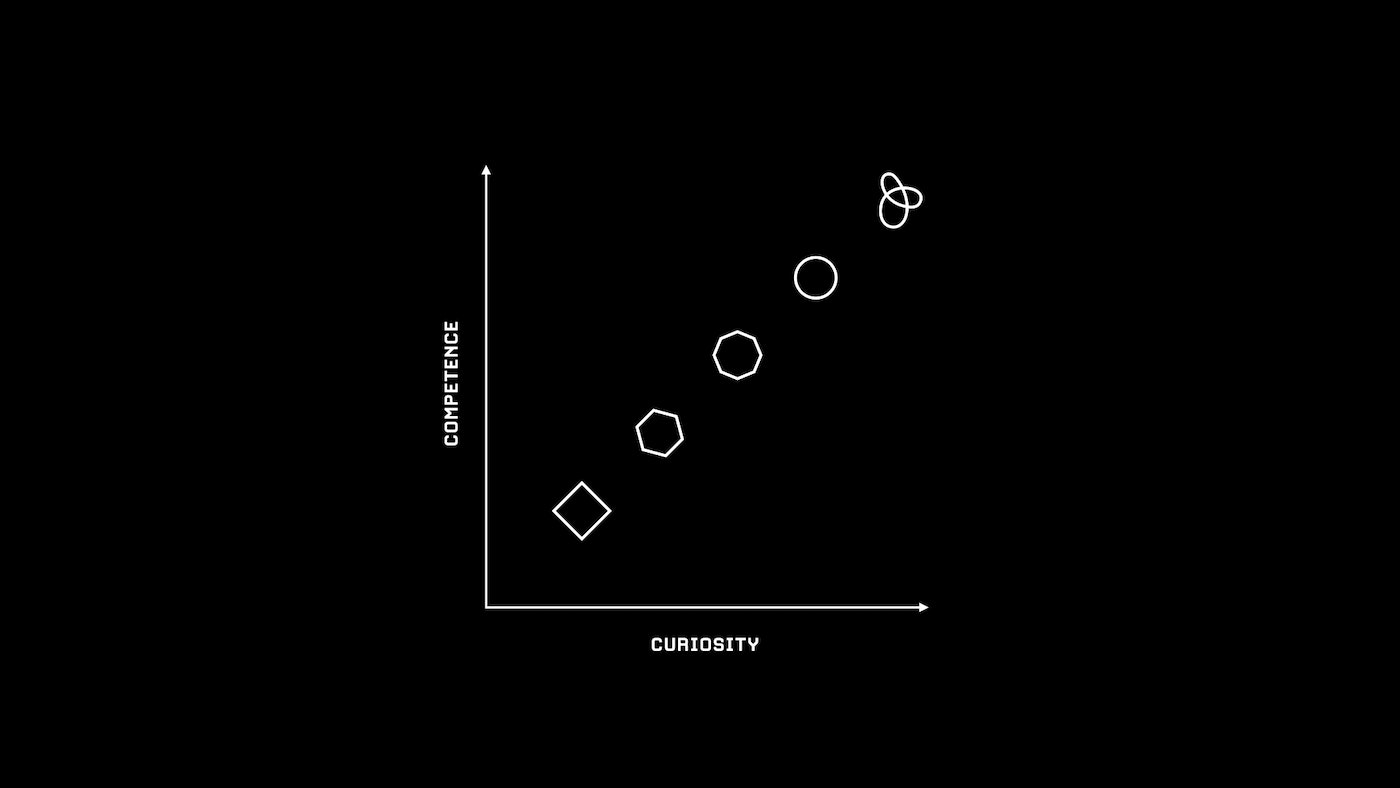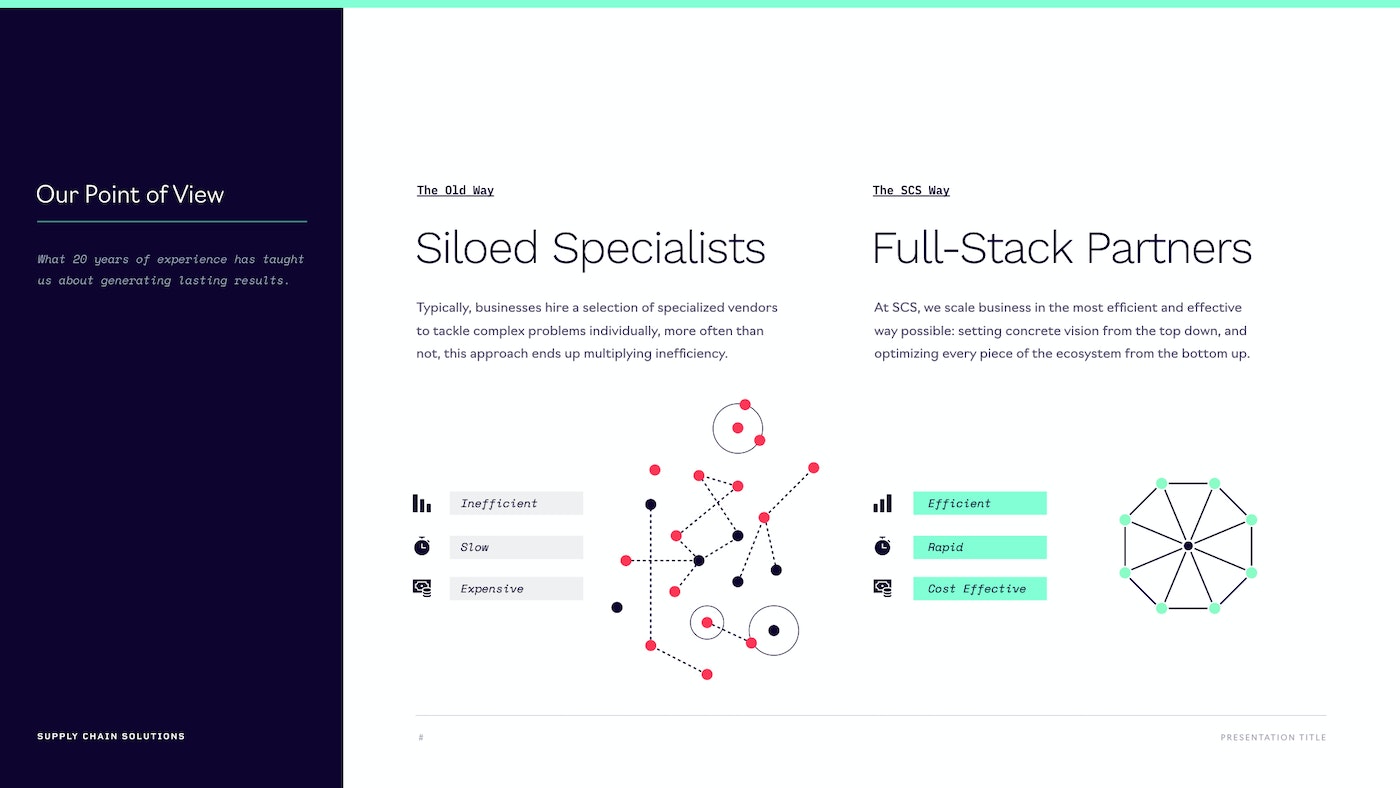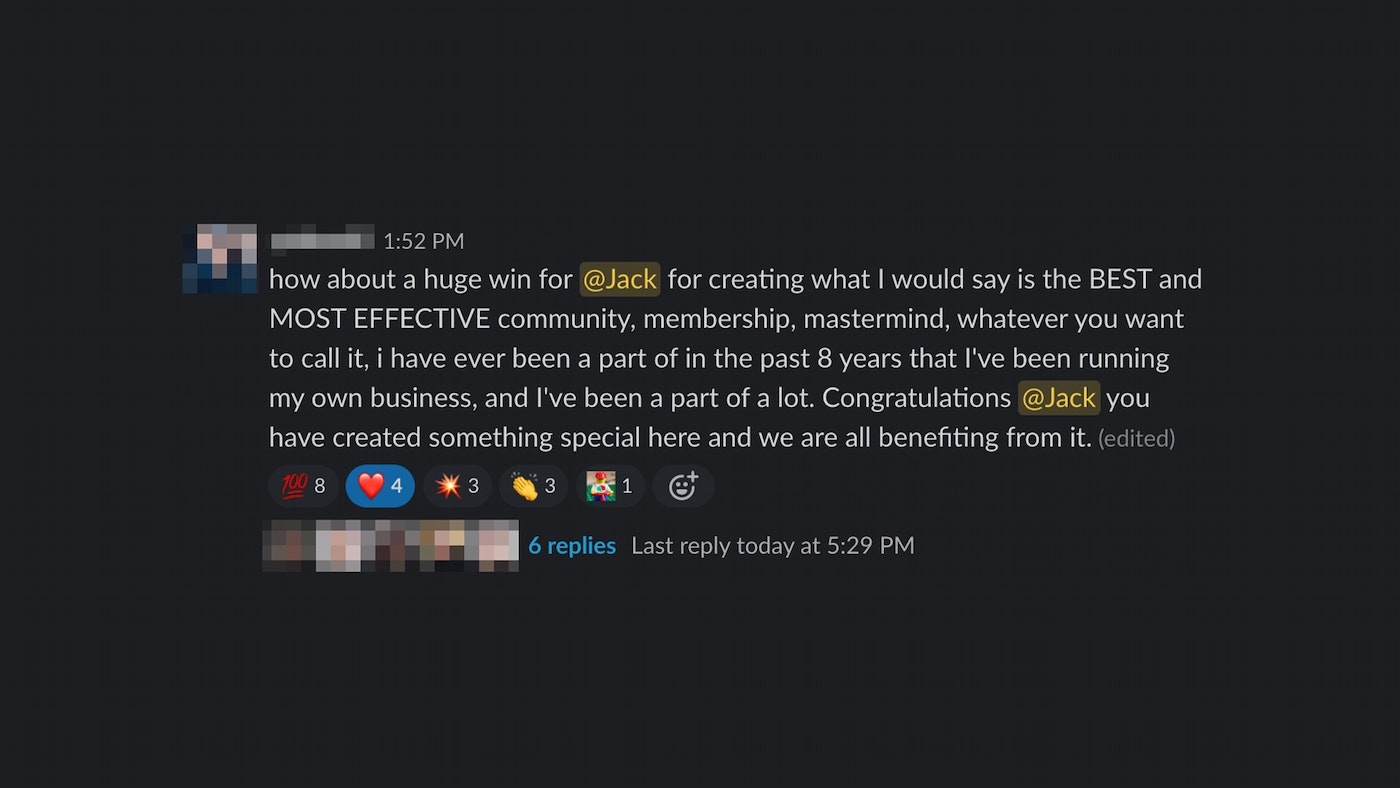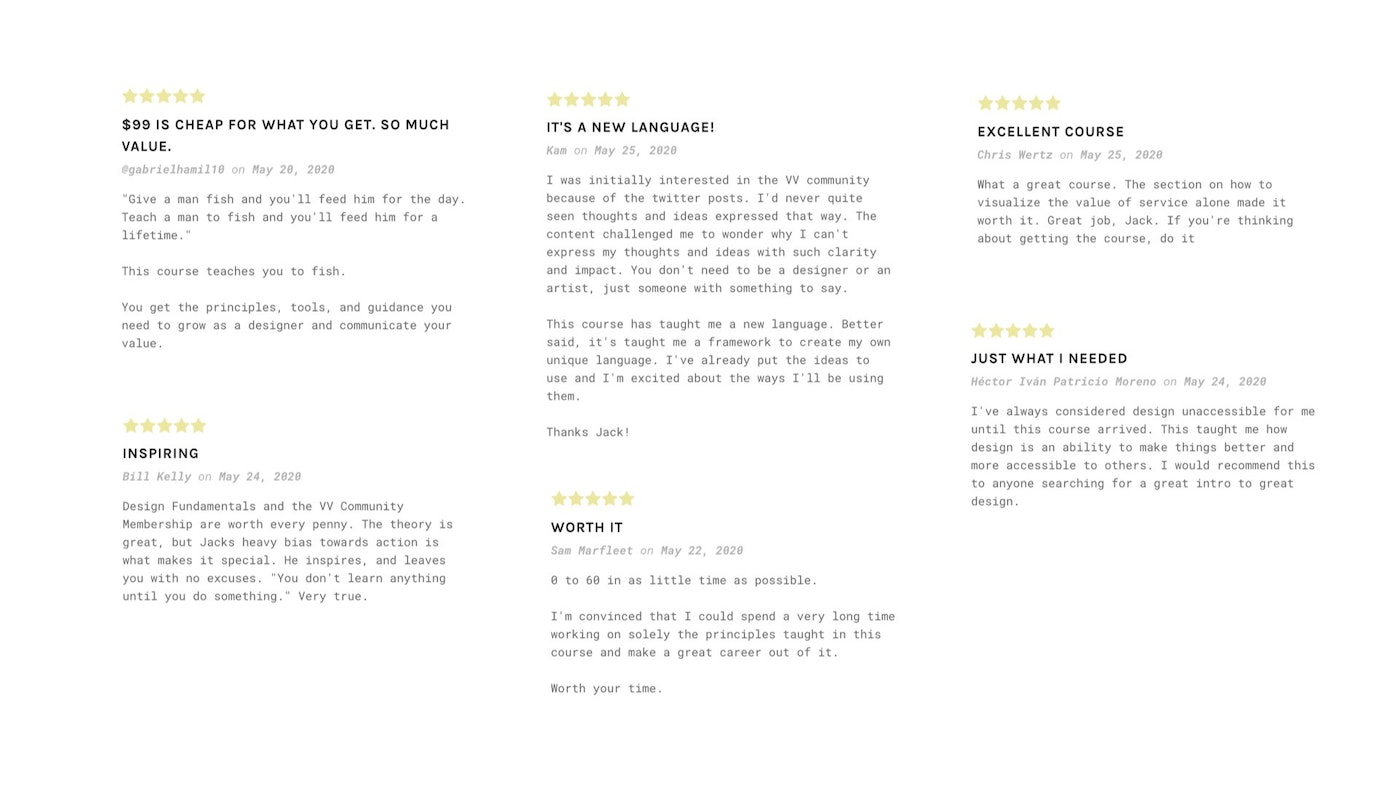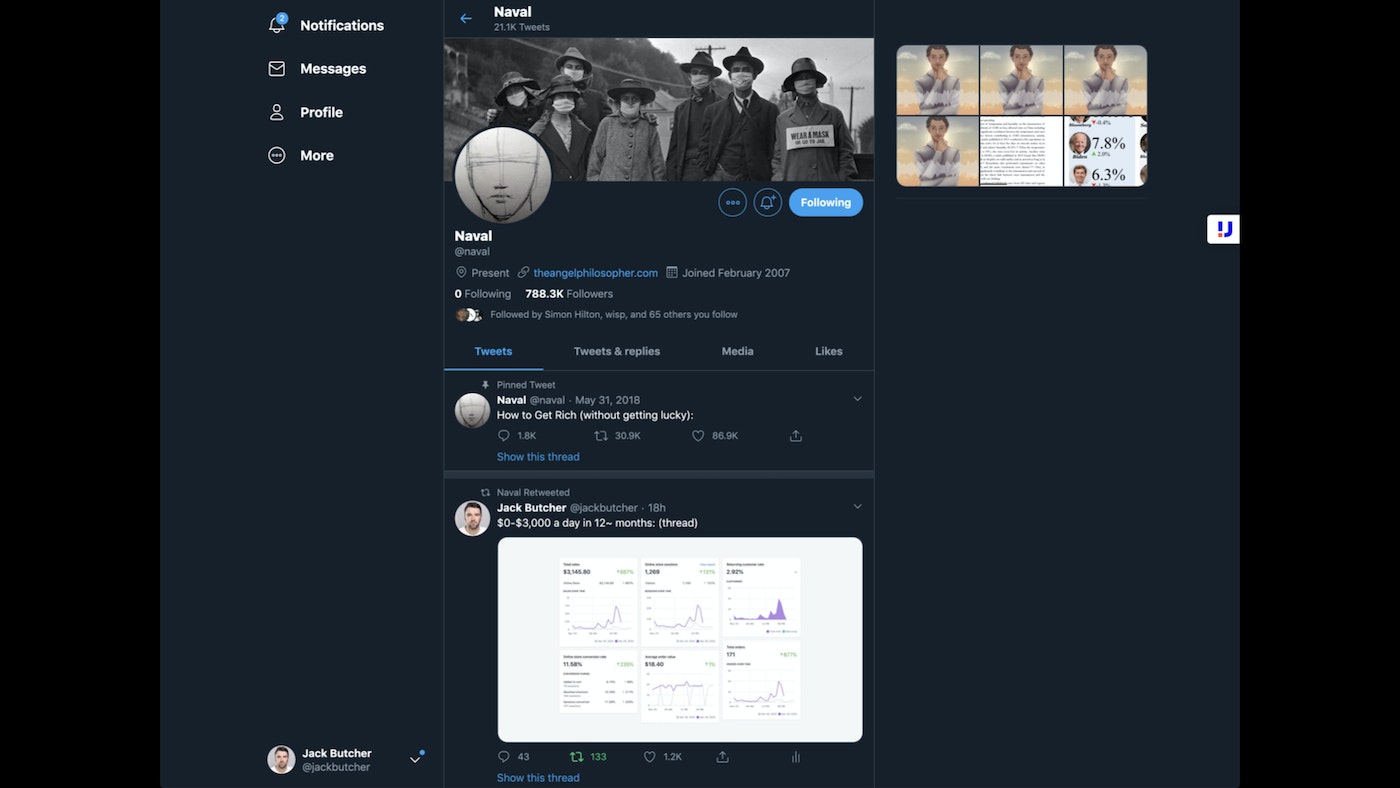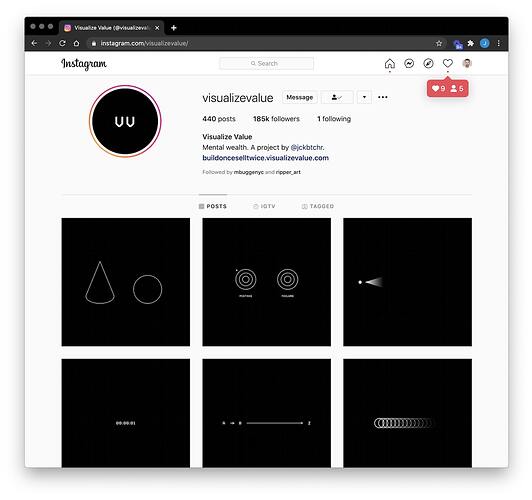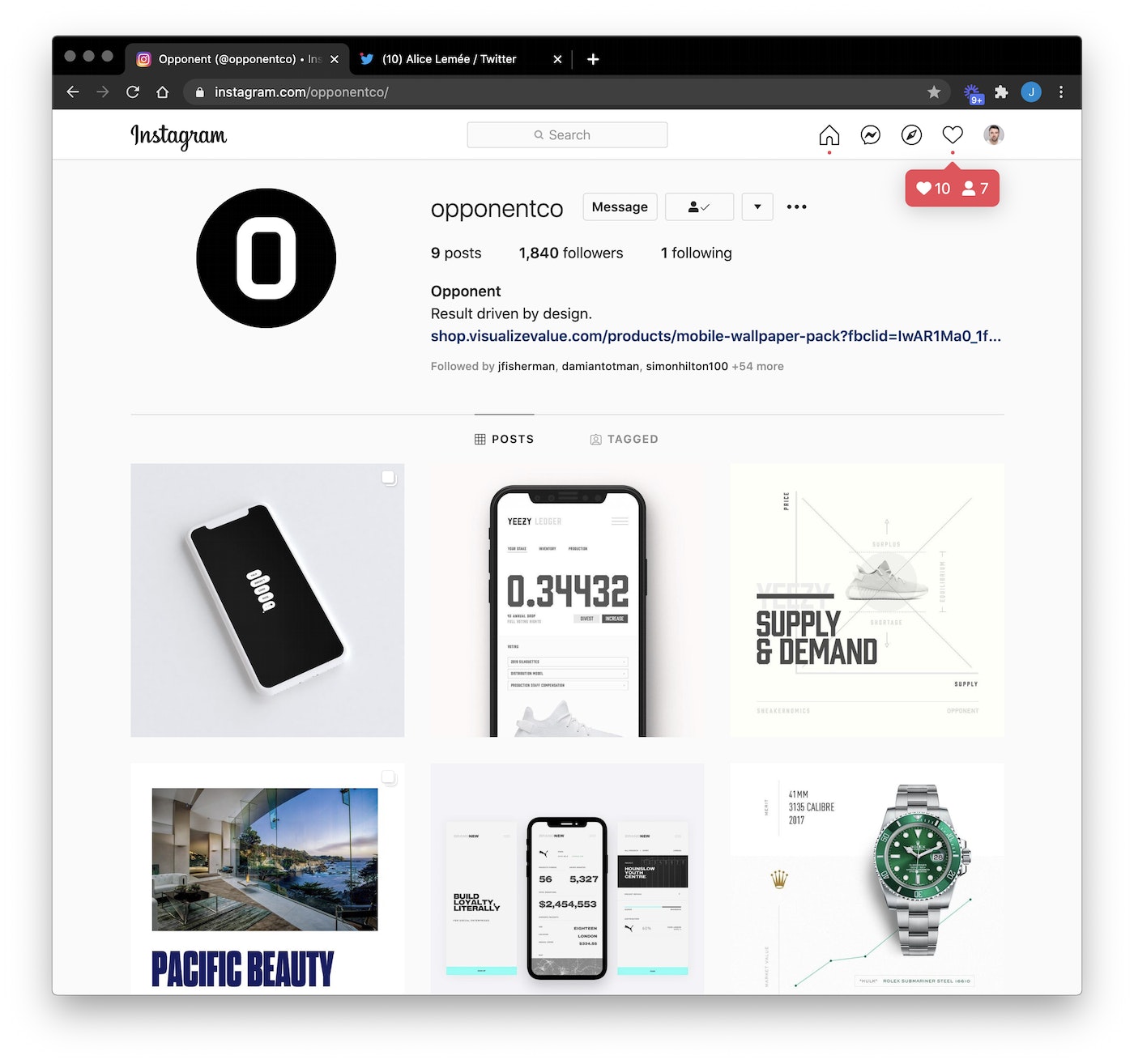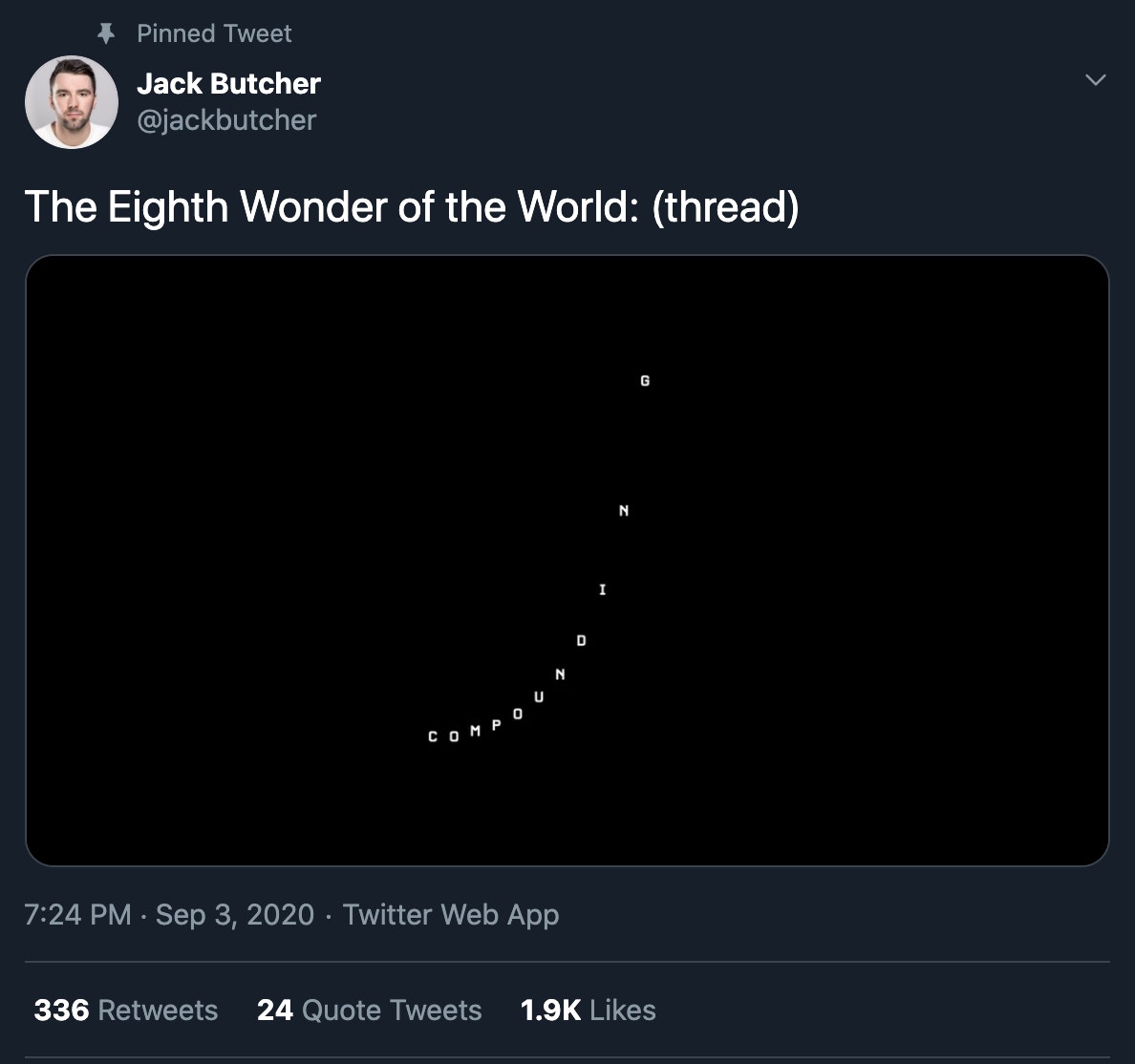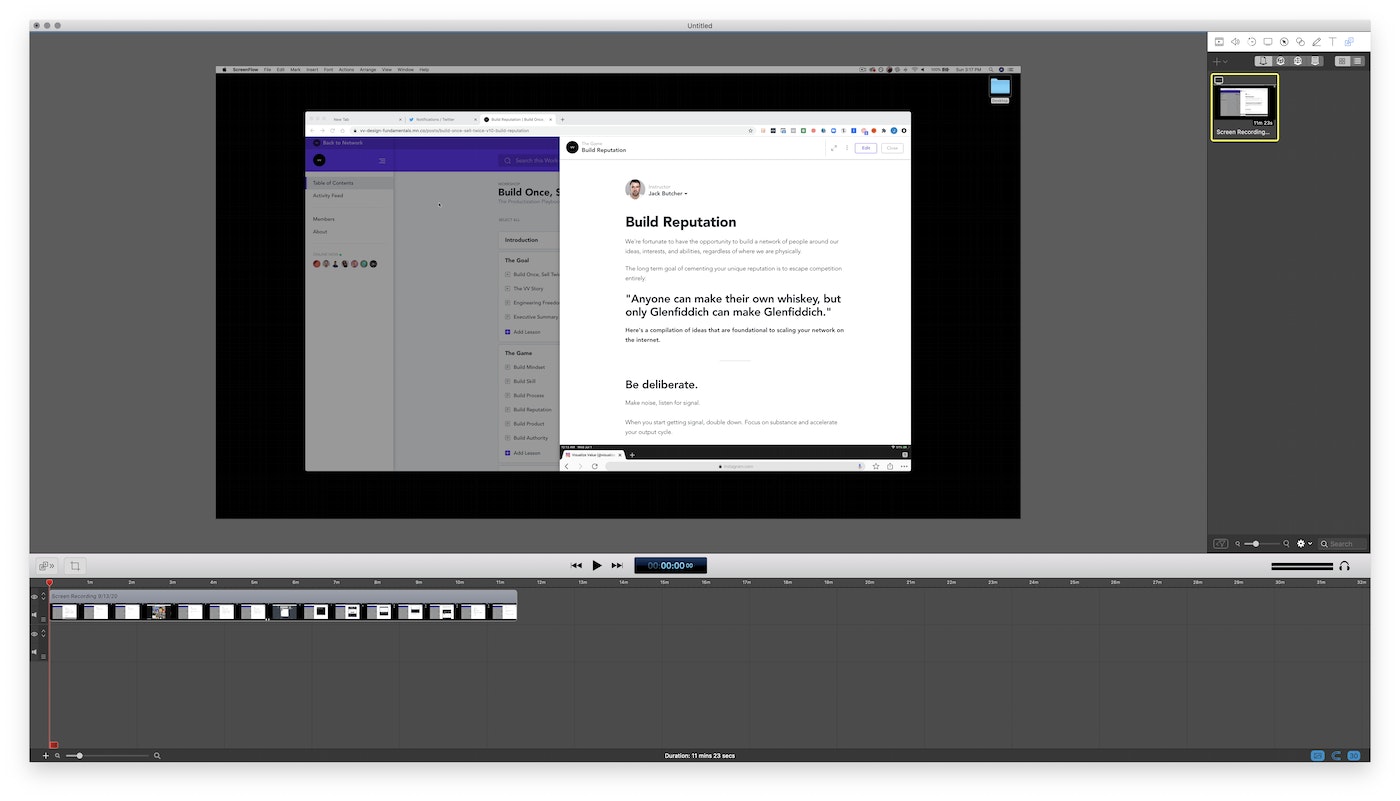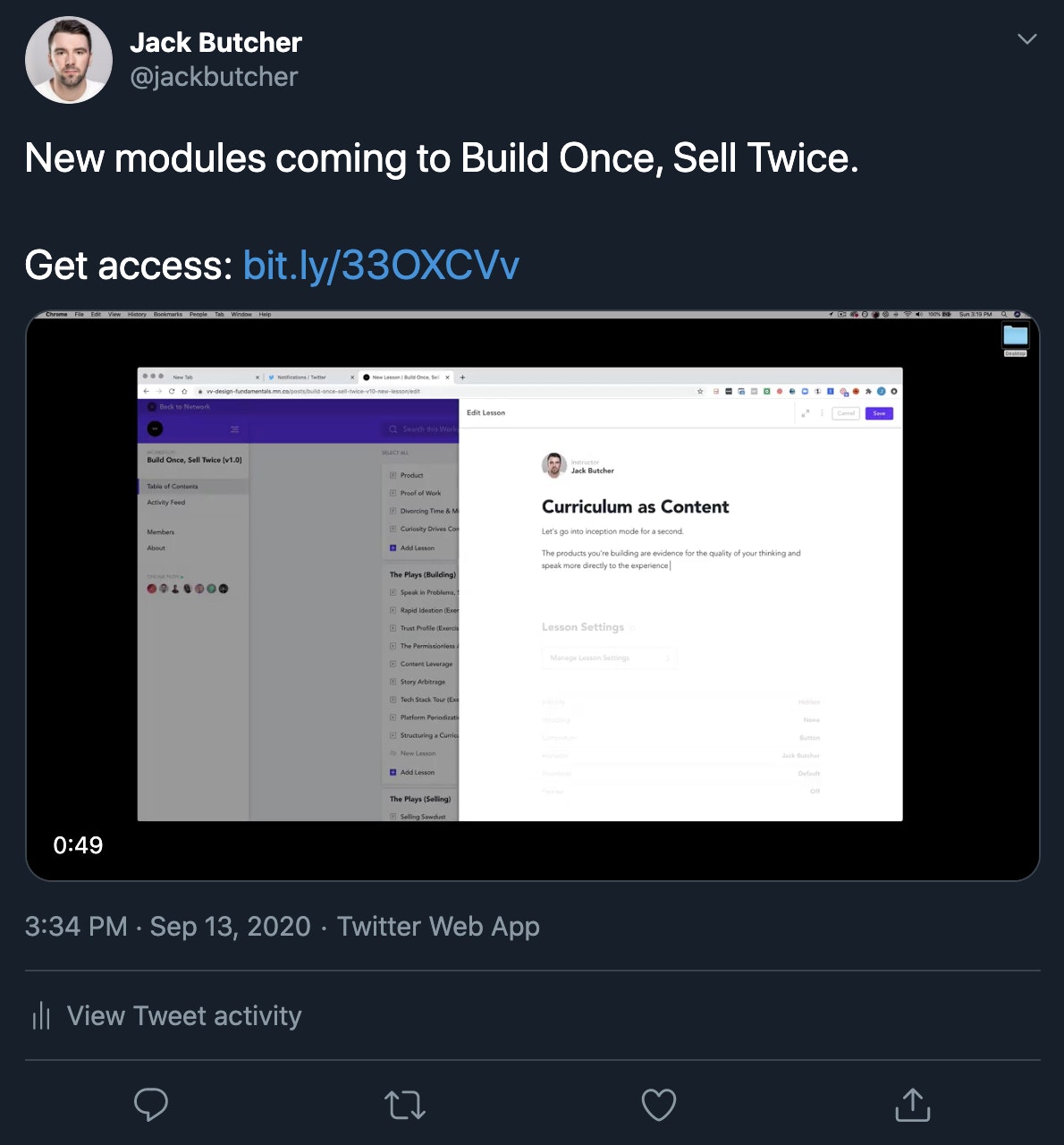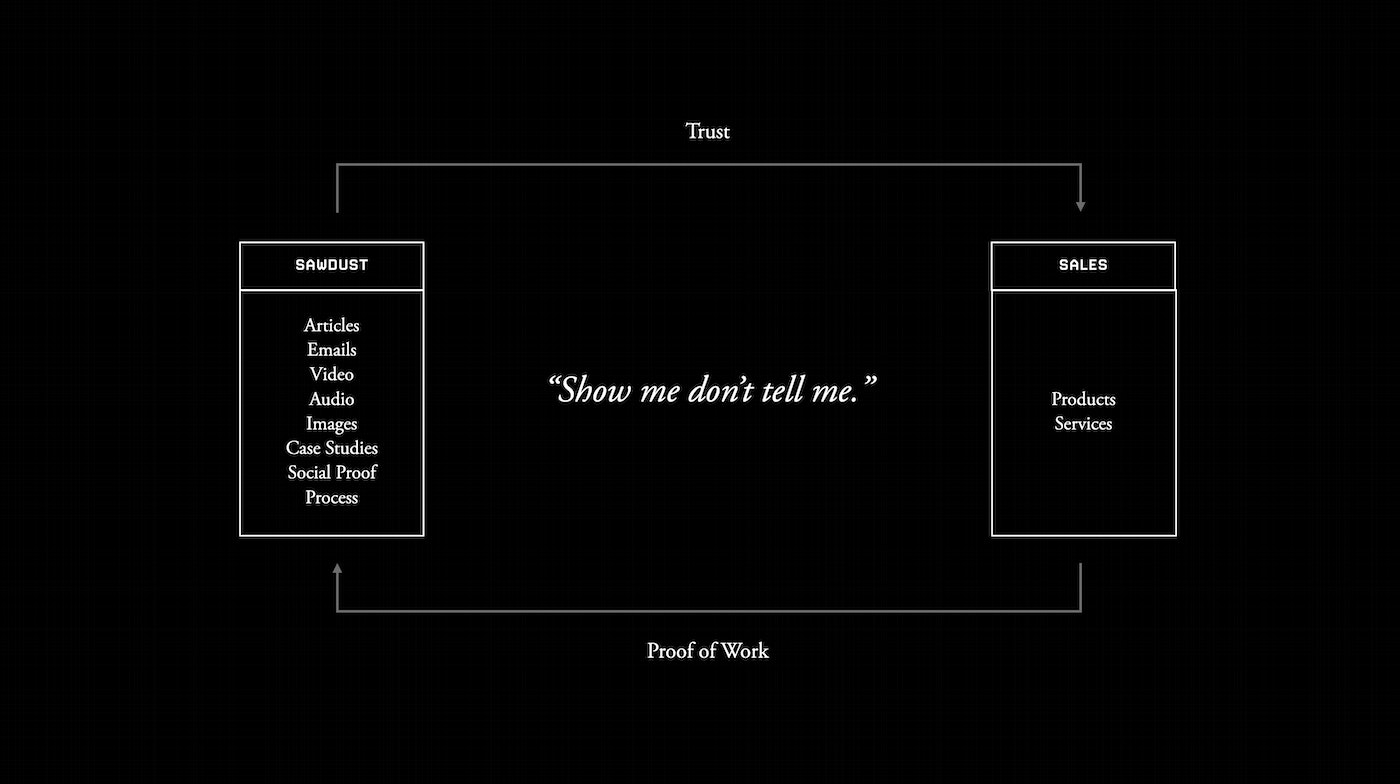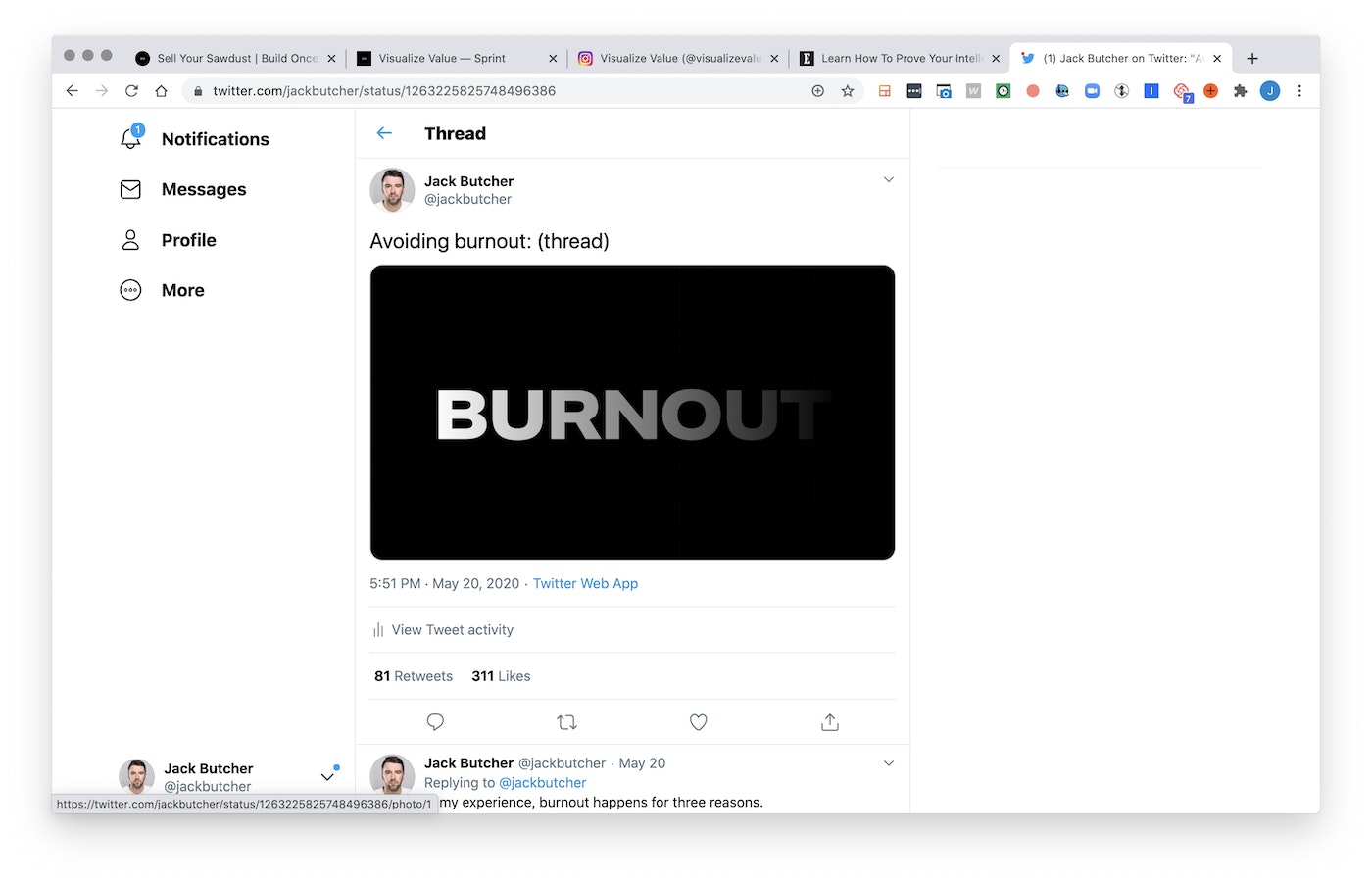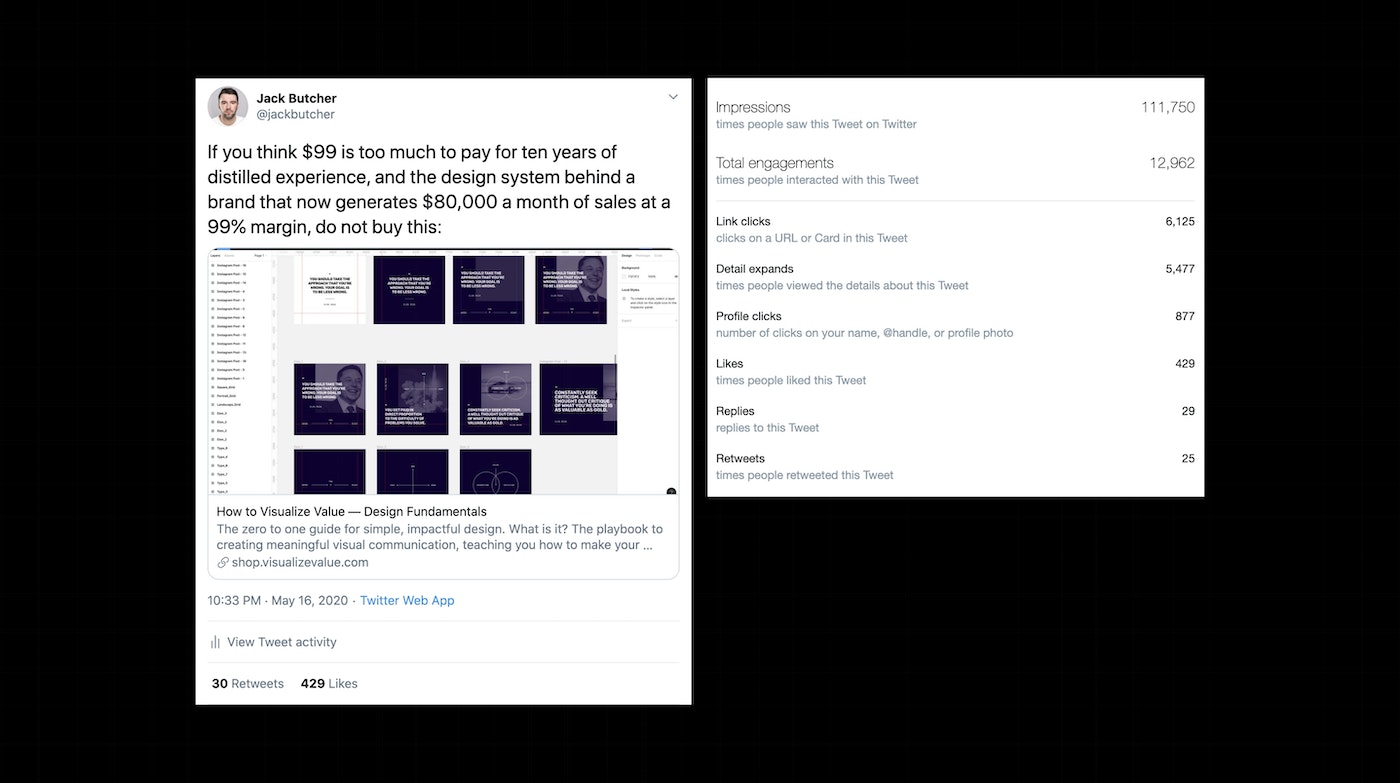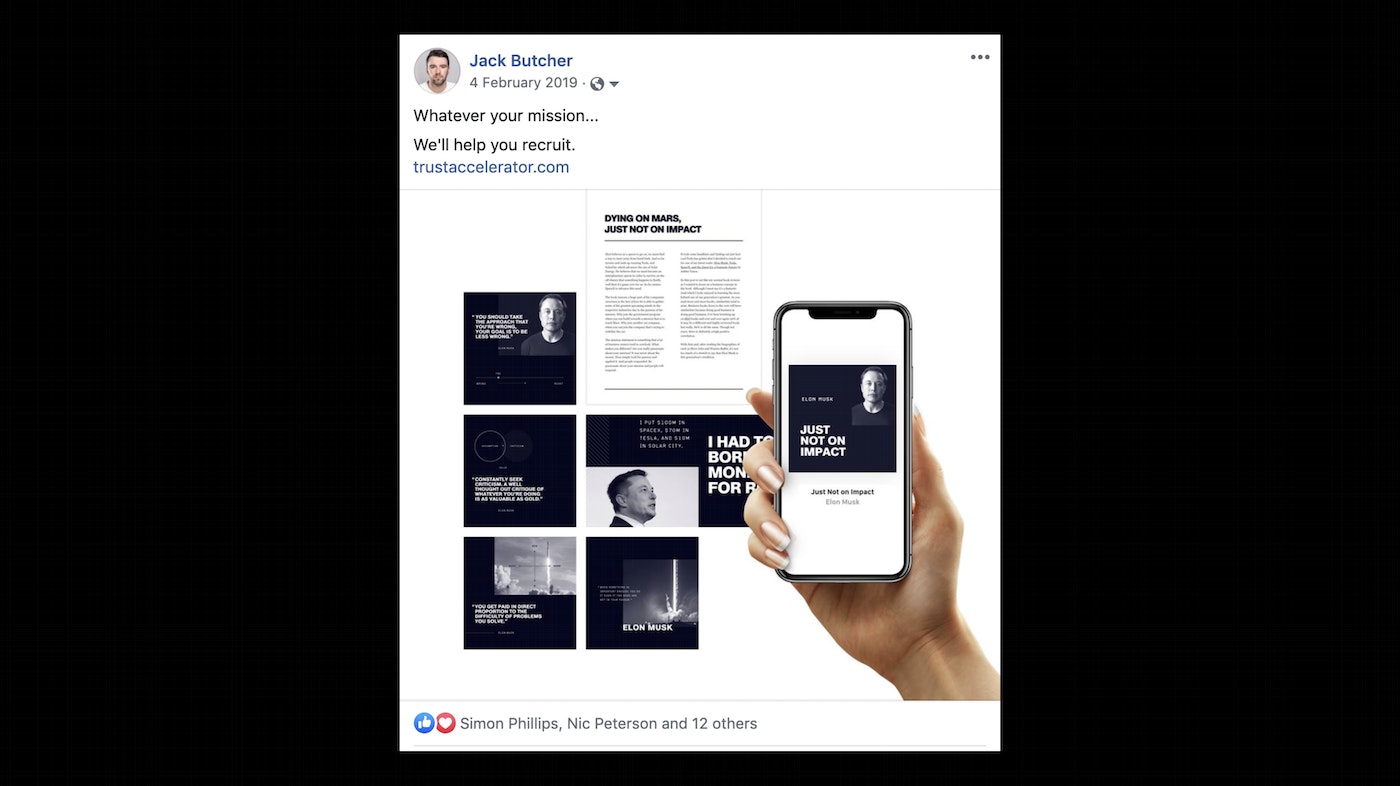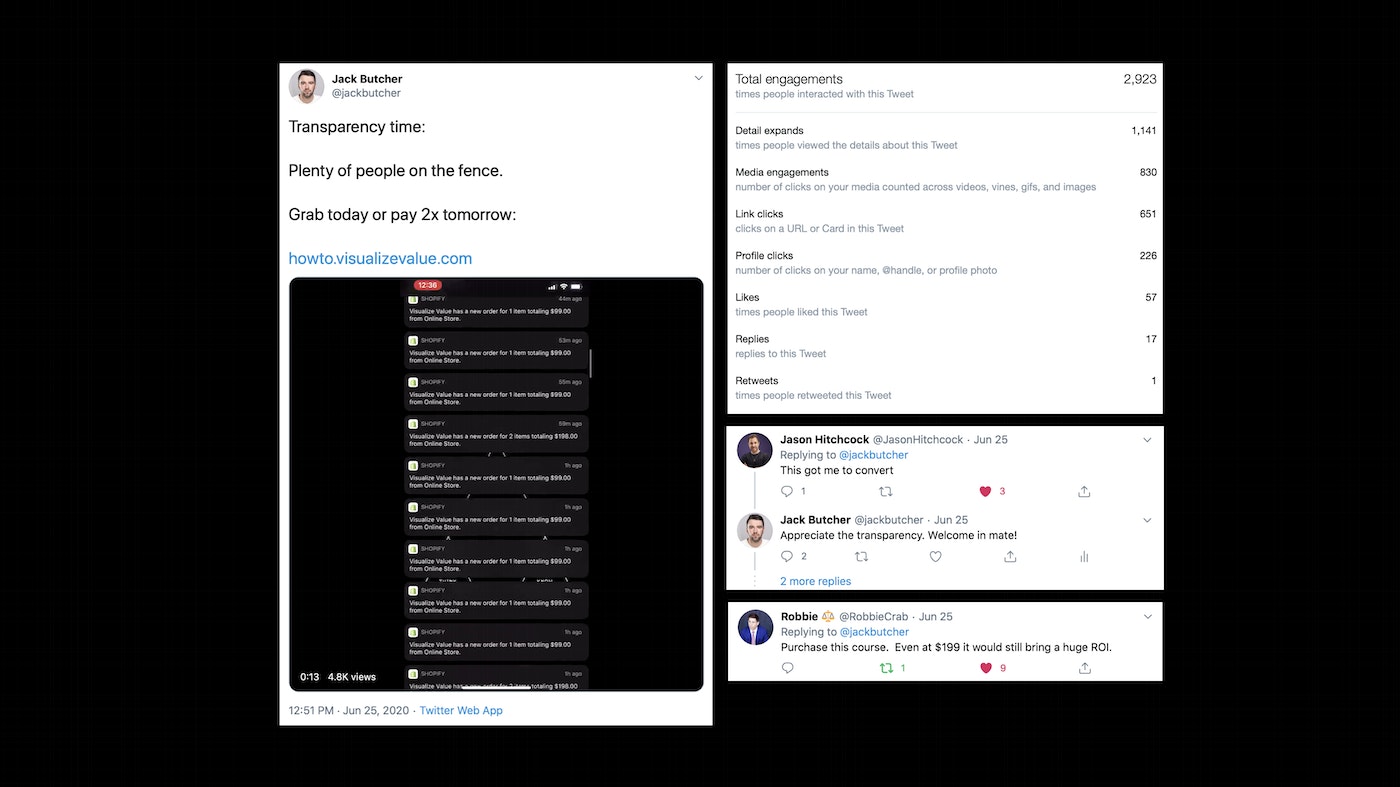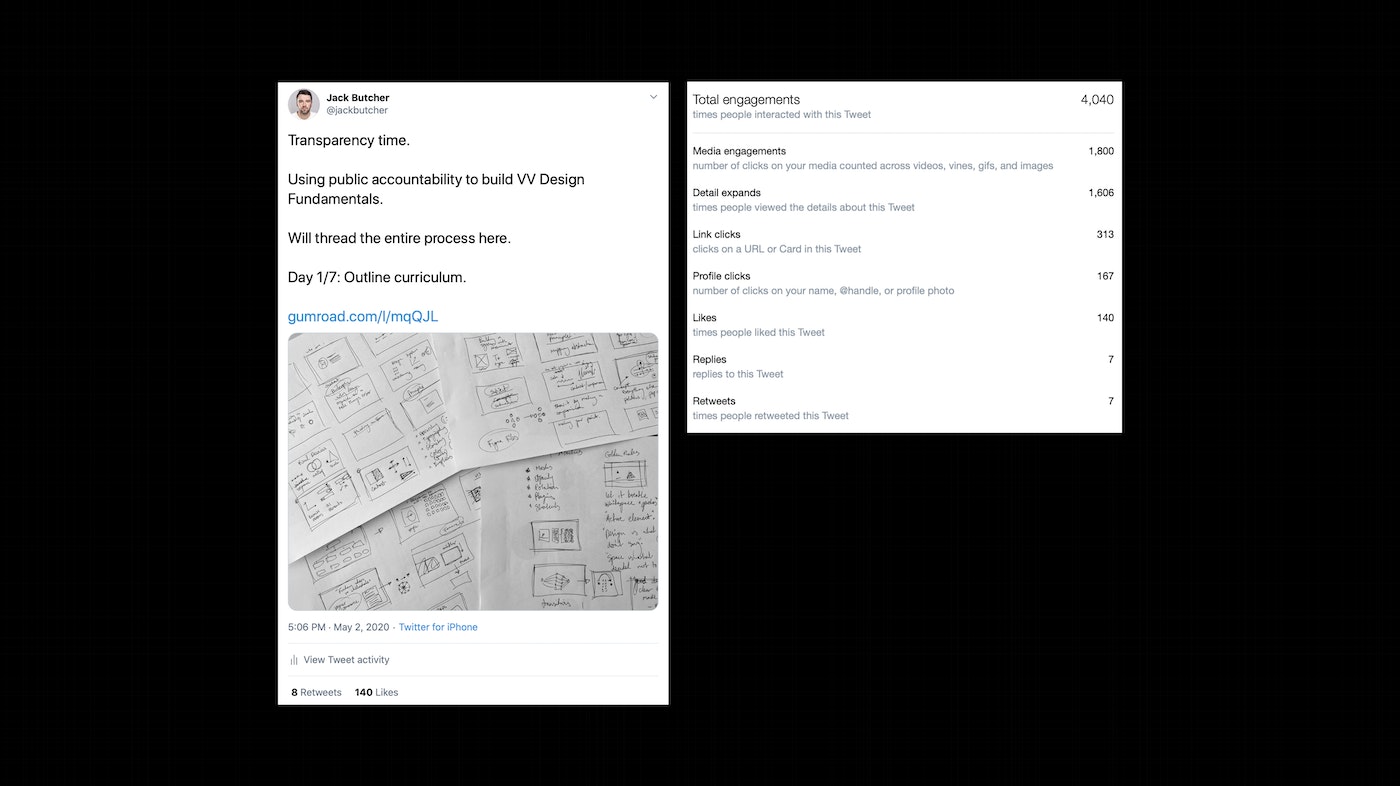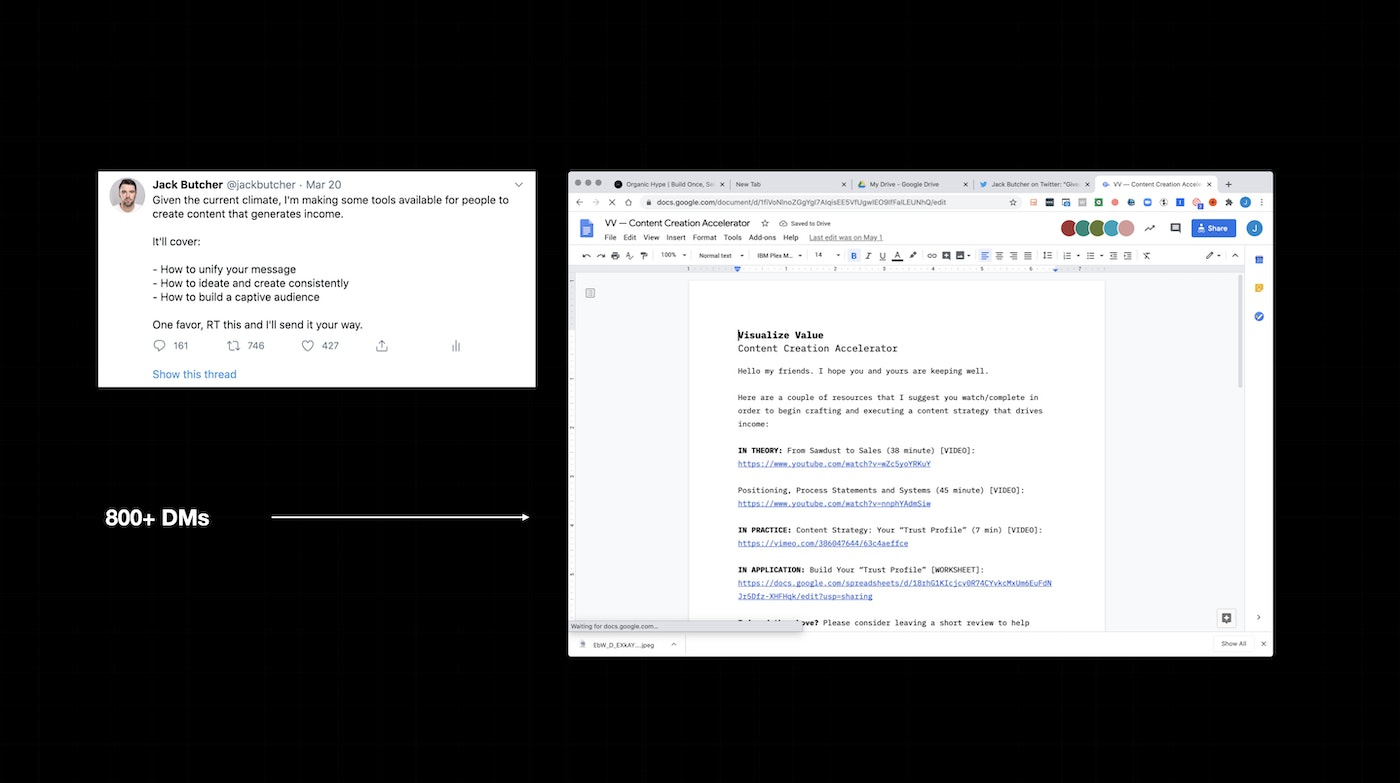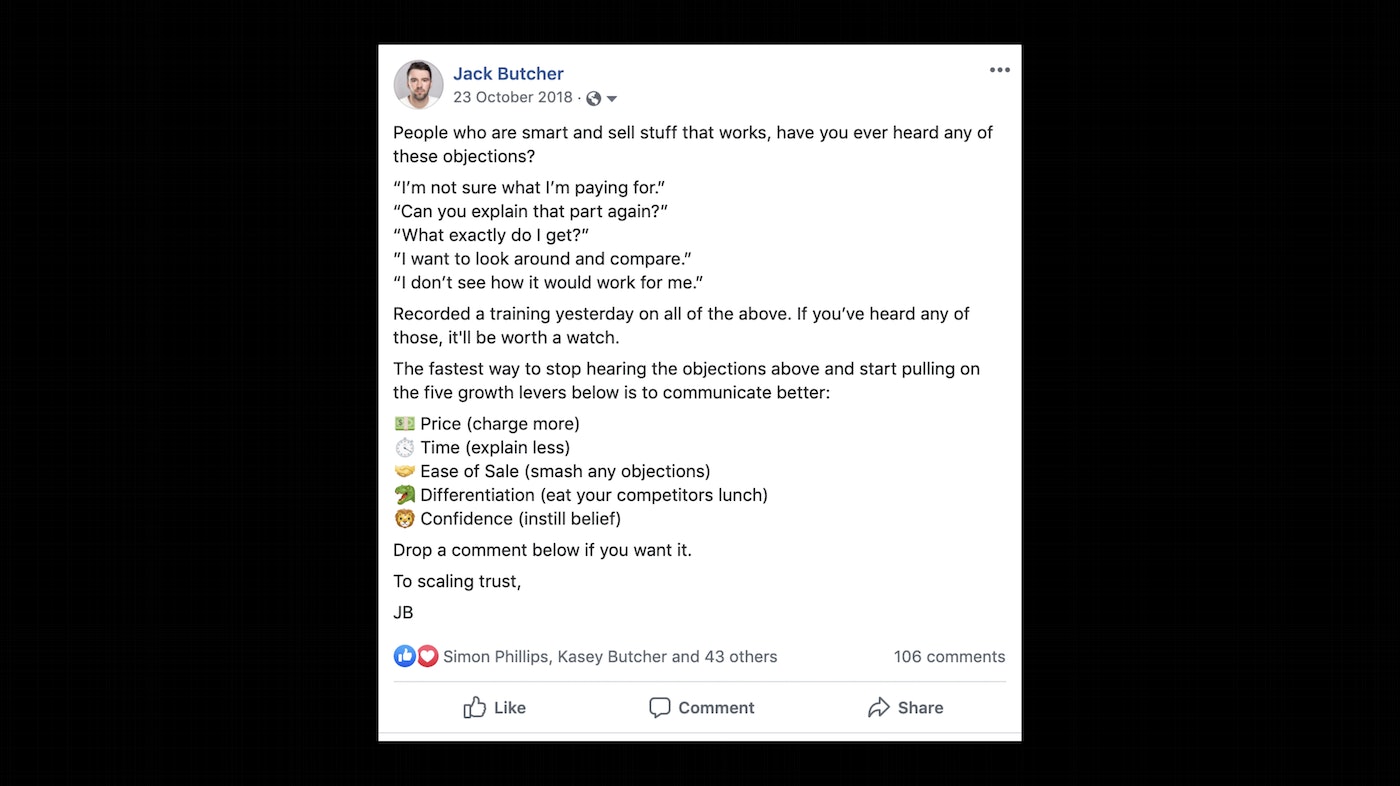Product
Rule #11: Build assets.
“To make money while you sleep, build things that don’t sleep.”
Enter product: The holy grail of digital freedom.
A simplified way to think about what’s happening across these tiers:
Service is work without process. (getting specific knowledge)
Productized service is work with process. (stabilizing your time & income)
Product is process without work. (buying back your time)
Proof of Work
Rule #12: Promote yourself.
This incredibly simple concept has been responsible for the entire trajectory of my career, both as an employee and a business owner.
No one cares what you can do, everyone cares what you can do for them.
Whether you’re building a software company, a productized service business, an information product, proof of work will accelerate your journey.
“Show me, don’t tell me.”
Now, not all of us are designers or think of ourselves as being able to produce “tangible” assets that represent what we do.
I am here to call BS on that idea.
Whatever it is you do for a living, at some point in the process you have to communicate the result of your effort to someone.
A document, a video, a presentation, a voice recording. Find a way to turn your results into assets that continue to build equity.
Private businesses are not obligated to share the details of their operation, and most don’t - in the public markets, information about the performance of a company drives its value. The same is true for you.
Show you can solve a problem and you’ll earn attention and capital.
It’s also worth noting that you’re creating proof in real-time when you work.
Use tools like Screenflow and Loom to capture your process, and promote it on the front end - we’ll go deeper into this in Sell your Sawdust later on.
Divorcing Time & Money
Rule #13: Get paid what you’re worth.
In order to get paid what you’re worth, you need to separate the arbitrary connection between your time and your money.
The paradox here is that how we spend our time determines how much value we can ultimately create.
Here’s a simple example:
The person on the left-hand side of the diagram below is selling their time. It could be to an employer, it could be to their own business. It doesn’t matter - there is still a ceiling on how much they can earn, a limit set by the natural universe. You can’t create more time.
However, you can create more value. On the right-hand side of the diagram we’re looking at a different equation. This person is building assets with their time. They show up on day one, put effort into something, and it’s worth more on day 2, they invest again on day 3, 4, 5, etc.
When you sell time, the count resets every morning.
When you sell value, the count rolls over.
To make this even more tangible, let me give you a personal example.
Selling time:
I have a client who I love working with, and I spend 4 hours a week working with them. I charge $1,250 an hour. That’s $5,000 a week.
Selling value:
I spend the same 4 hours adding new modules to a $499 Visualize Value digital product, spend 20 minutes promoting it organically, and sell 10 copies. Another $5,000. The difference is, that product is available to purchase infinitely, with no additional effort required from me to fulfill it.
To divorce your time and money, build assets that work without you.
Curiosity Drives Competence
Rule #14: Keep Iterating
“Become the best in the world at what you do, keep redefining what you do until this is true.” — Naval Ravikant
The fastest way to learn a new skill: U se it to communicate something you care about to people.
Your competence increases your perceived value.
Your curiosity increases your ability to produce consistently.
When your curiosity makes you more competent, you have exited the realm of competition entirely. You are getting paid to play.
It took a long time to deny the instinct that work should feel like work, but there’s a distinct difference between working because you want to, and working because you have to.
Deciding you want to make the hall of fame is not the same as deciding you’re going to spend every day becoming a better player.
You get a lot better a lot faster when you enjoy the game.
Speak in Problems, Solve in Products (Exercise)
Simplifying the concept of problem/solution.
All we need to do is answer the following questions:
What’s the problem?
How do we know it’s a problem?
What’s the solution?
How do we summarize the solution?
How do we prove it works?
The answer to every question becomes a driving force behind the way we think about, talk about and build each product.
Problem: Business owners struggle to articulate their value proposition.
How do we know? Validated by response to publishing VV pitch decks.
Solution: Visualize Value Sprints.
Summary: We clarify & codify your value proposition.
How do we prove it works? Do it for ourselves first. Client testimonials and case studies.
Problem: Business owners don’t realize the value of their own knowledge.
How do we know? Interviews with clients that can’t see their value.
Solution: Visualize Value Trust Profile. (previously Trust Accelerator)
Summary: A done-for-you content strategy.
How do we prove it works? Client testimonials and case studies.
Problem: Entrepreneurs struggle to stay focused and structure their day.
How do we know? Answering hundreds of questions on Instagram.
Solution: The Daily Manifest.
Summary: A sticky system for self-organization.
How do we prove it works? Customer testimonials.
Problem: Entrepreneurs don’t have a support network locally.
How do we know? We didn’t have one, so we built one.
Solution: The Visualize Value Community.
Summary: Building a network of builders.
How do we prove it works? Community testimonials, member results.
Problem: Words don’t communicate ideas as effectively as images.
How do we know? People told us VV helps them grasp concepts better.
Solution: How to Visualize Value — Design Fundamentals
Summary: The zero to one guide for simple, impactful design.
How do we prove it works? Student testimonials.
Problem: The one-person service business causes burnout.
How do we know? We built one and burned out.
Solution: Build once, Sell twice — The Productization Playbook (hello!)
Summary: Secure your future by building a reputation online.
How do we prove it works? Student testimonials.
The Permissionless Apprenticeship
If you’re reading this, you have the ability to seek out the types of people you want to work with and produce something for them for free.
The upside to this technique is enormous, you get something, they get something, your audience gets something, their audience gets something. A true positive-sum game.
This was one of the largest growth levers in the early stages of the Visualize Value business.
I did this by studying and making artwork for my favorite thinkers, the most notable being Naval Ravikant and Nassim Nicholas Taleb.
Whatever your pursuit, you have access to hugely influential players in your space via a network like Twitter.
Personal vs. Project Brands
“Should I start a personal brand or a company brand?”
This is a question we receive on a weekly basis.
Our opinion on the difference between personal brands and company brands is not a one-size-fits-all recommendation, but more of a perspective on what to consider.
The first thing to acknowledge is that you can build a personal brand by simply publishing your ideas on any given platform where you have a profile. The investment to start and maintain a “company” brand is a little different. Since “company” has such a broad set of connotations, we’re going to use the term “project brand” to distinguish anything that isn’t a personal brand.
So when do “project” brands make sense?
In some circumstances, a project brand can create more optionality in the long-run. The advantage of a brand not being attached to an individual widens the set of possibilities for expanding a team, producing a portfolio of products, and potentially selling the company in the long-term.
The short-term downside here is it takes longer to form an attachment to something that is a couple of steps removed from an actual person.
The upside is the ability to confine and document a specific project over the long-term.
For example, @jackbutcher on Twitter is far more effective in converting sales for Visualize Value products than @visualizevalue. Why?
Our hypothesis : People buy from people. The signaling of skin-in-the-game and accountability that comes with selling products under your own name can also not be underestimated.
Does that mean the Visualize Value brand should not exist? No.
Why not? Because it creates equity in a specific “project.”
Performing some hindsight analysis, the early focus of Visualize Value (thematically consistent black and white images) likely captured more attention and subscribers due to people buying into the “product” (the only product early on was the content itself).
Had the same content simply been posted as 25% of the content published from @jackbutcher, the same may not be true. Not everyone is interested in the other 75%.
Our guess is VV is an easy follow for that reason, if you like 1 image, chances are you’ll like the next one too.
As always, it comes back to the consistent ability to produce things that people enjoy consuming. There is no exact formula, but if you have an idea that is focused enough to warrant a “project brand,” there’s a strong possibility that by separating it into a different feed, you’ll capture a more significant audience, and grow equity in something that doesn’t depend on your name and face in perpetuity.
In our case, when VV reached critical mass (a few thousand followers) we began to leverage it to grow @jackbutcher - we eventually added “A project by @jackbutcher” to the VV Twitter bio (and it was the only account VV followed). We began to occasionally expose the VV audience to the thinking behind the brand, and giving them the option to opt-in or out of that story.
We continue to leverage the VV platform to repost @jackbutcher’s Tweets within the brand feed - after a few weeks, we usually go back through and clean up the @visualizevalue account by removing any retweets for the sake of cleanliness.
Again, this is not an exact prescription, but an ongoing feedback loop that combines the gut instinct you will develop and the data you can read.
Some more anecdotal evidence from our experience:
Before Visualize Value, we built a small advertising agency in 2017 named “Opponent” - presence across social platforms was table stakes, but we didn’t do a great job of producing engaging content.
That said, the brand was a useful tool in establishing credibility, no Fortune 500 company is doing business with “Jack & Celia Butcher LLC.”
Again, the ability to scale on social media is heavily determined by the level of focus applied to the content produced.
Why would someone follow this? What’s in it for them? We still couldn’t answer these questions in Opponent’s case.
When Visualize Value began to gain traction, the mistakes we’d made here became obvious. We lacked the focus that would keep people coming back.
We were not passionate about or interested in running a one-size-fits-all, me too, advertising agency.
Now, Opponent is nothing more than an inactive Instagram page:
Together, Celia and I have been working on brands for a collective 20-years of all sizes and industries, and a lot of it comes down to experimentation, intuition, and gut.
It’s all a series of feedback loops, that must be driven by an innate interest to have any chance at survival.
Content Leverage
Learning to properly leverage content is a game changer for any business.
On both the front and back end of your operation, content is a tool that eliminates the need for you to repeat yourself.
Record a lesson once, play it to 1,000 students.
Record your product overview once, send it to 100 investors.
Write an article once, publish to 100,000 readers.
Story Arbitrage
When we monetize our specific knowledge, we are tapping into an arbitrage opportunity in the market that nobody else has access to.
“A company is successful to the extent it does something other companies can’t do.” — Peter Thiel
With that in mind, the growth vector for a company of one is hugely influenced by how authentically you behave.
“Escape competition through authenticity.”— Naval Ravikant
There are a million courses, YouTube channels, podcasts, blogs, websites, books, events and trainings on building online businesses, but you’re here watching this one.
Why?
Platform Periodization
A short and sweet lesson here.
We mentioned above the importance of omnipresence across platforms, the repurposing of content, but here’s a perspective on where to start:
To grow faster, focus on reaching critical mass on a single platform, then deploy your earned capital into a new investment.
Example:
Spend 6 months mastering one platform: Build an engaged audience that you can leverage into new platforms as you dial in your message.
Spend 6 months trying to grow on 4 platforms: Split your focus across 4 groups of people, asset production, and community management.
Who’s going to be better off in 6 months time?
Structuring a Curriculum
How do you turn a result you’re providing as a service into a product that people can buy?
Reverse engineer from the result.
The best way to validate you’re delivering the transition you’re selling? Find someone who hasn’t made it and work with them to develop your product.
It’s a simple construct that will help you regardless of what it is you’re teaching:
Philosophical (foundational knowledge)
Practical (real world application)
Psychological (overcoming barriers in implementation)
Curriculum as Content
Let’s go into inception mode for a second.
The products you’re building are evidence for the quality of your thinking and speak more directly to the experience your customer will have than any marketing abstraction will.
Said simply: let the building do the marketing.
For some context, the modules you’ve been through above lend themselves to marketing material on the front end (with a few little tweaks).
The “Compounding” Module above translates into a Twitter thread that leverages the same text and visuals:
Have a look at the whole thing here.
The only difference, it ends with a call to action that speaks to the rest of the curriculum.
“If you thought this was valuable, I have another 3 dozen concepts just like this…”
That final tweet drives traffic to the product page, that delivers a ton of social proof and more detail on what to expect if you buy.
In one week, that tweet storm that recycles content that I’ve already produced drove 900 clicks to the product page.
At 1% conversion (conservative) that’s 9 sales of a $297 product.
$2,700 for doing a bit of recycling. Not too shabby.
Let’s take it one step further — this entire exercise is a perfect example of the sawdust principle.
While I’ve been writing out this lesson, I’ve been recording my screen. Now I’ll take that video, post it on Twitter and let current (and prospective) buyers know that the curriculum is being updated with some more proven lessons that are being extracted from my business in real-time.
The above application is called Screenflow if you’re after something lightweight to produce screen recordings.
Writing this lesson isn’t just a value add to students, it’s proof of work, new marketing material, and additional content leverage.
Interrupting Patterns
I’ve been asked hundreds of times what I attribute the early growth of Visualize Value to.
There are lots of factors, the reverse influence strategy, the consistency of output, the creative restraint, the borrowing and building on top of already great ideas.
One huge thing, though — the ability to interrupt a pattern.
Think of your average day scrolling through Twitter or instagram.
Emulation everywhere.
Same on Twitter.
Monkey see, monkey do.
In an endless stream of oversaturated lifestyle photos and predictable meme formats, a black canvas with a few white geometric shapes stops your thumb.
Now this is not a recommendation to emulate a visual style (per se).
It is a recommendation to experiment with ways to stop thumbs by doing something drastically different.
Naming
What’s in a name?
Names are incredibly powerful tools, and hugely overlooked by most creative people.
We’ve covered the importance of language, but naming is a game unto itself.
A name should contain both meaning and intrigue.
Take “Build Once, Sell Twice” vs. “Digital Marketing Course”
One is a specific and memorable phrase that points at an outcome, the other is generic, and I’d argue meaninglessly broad, which essentially means it’s invisible.
Just as musicians have a handful of memorable tracks that are responsible for the majority of their commercial success, the same is true in naming the assets you create as a digital entrepreneur.
Selling Sawdust
One of the fundamental ideas behind building reputation online is consistently generating proof of work. The beauty of this idea is that most people are already doing it (they’re just not sharing it).
Everything you do is valuable to two audiences:
- Clients will trust that you can do it for them.
- Customers will trust that you can teach them how to do it.
The concept of selling sawdust is simply sharing the byproduct of your work.
For example: In developing this course, I have written pages and pages of notes that will fuel front-end content for months, I’ll expand one-line notes into emails, Twitter threads, and Office Hours content for the VV community.
The fidelity of your ideas increases as you share them.
A powerful idea by Marc Andreesen summarizes the value of proving yourself in public. You don’t know what’s going to resonate with your audience until you publish.
If you build your audience on top of demonstrable proof, the path to product and service sales is frictionless.
Example:
Person x follows you because they are interested in you sharing how you’re building your business. When you release a product that they can use to get a closer look at the nuance of your strategy, they’re already bought in, you just need to collect the credit card details.
Continually proving your ability to generate a result is what builds trust with your audience, and drives sales of your products and services.
In the context of Visualize Value, sawdust is everything from repurposing presentations as front-end marketing assets:
When you build your audience with transparency, you can sell with transparency.
Selling to Sellers
For those accustomed to working for clients in a B2B capacity, our typical instinct when transitioning to building products is to make something for those same people.
Not a terrible strategy by any means, but allow me to explain an alternative frame for expanding your opportunity.
There is the market of the end client:
People who can implement what they’ve learned in their business.
“Here are the tools to visualize your value proposition.”
And there is the market beyond the end client:
People who can mark up what they’ve learned and sell it as a service.
“Here’s how to help your clients visualize their value proposition.”
A small tweak in positioning expands your market massively.
Why does this strategy work?
It’s why you’re reading this sentence right now. In building content, documenting your journey, and “selling your sawdust,” you’ll capture the attention of people who aspire to follow in your footsteps, giving you the opportunity to make product for those a few steps behind you.
Organic Hype
You get paid in direct proportion to your ability to generate attention and convert it to a sale.
Below, I’m sharing the marketing frameworks that have driven huge results for Visualize Value products. As of today, we’ve spent $0 on paid ads and generated over $330,000 in digital product sales.
Create Urgency
In order to get people to act, run campaigns with limited variables (x number of people at price x, x number of days to buy x).
Answer Questions in Public
Take the questions you’re asked frequently and write an explanation publicly - your engaged customers will back you up, creating an even more powerful asset to convert cold traffic.
Early on, I would ask things like “what do you need help with?” or “what are you struggling with?” on VV’s Instagram. I’d post the questions and answers to Instagram Story and found that always drove engagement. Plus, it was an authentic way to know who my audience was and what they needed, especially from me.
Endorsements
Let your customers do the marketing for you. Leverage what your customers say about your product into marketing assets.
The “Reverse” Pitch
Forcing your audience to consider the inverse proposition (don’t take action if you don’t want to experience x, y, and z…)
Problem/Solution
Talk very specifically about the problem your client faces (that your product solves), and position yourself as the answer.
Permissionless Proof
No client? No problem. Leverage culture to create examples of your output, approach, or thinking. You don’t need permission, you just need proof.
Case Studies
Post social proof, on social networks, and get it endorsed by the clients that paid for it. Dynamite lead magnet.
Transparency
Be outrageously transparent about the success and failure of your business in order to build trust with your audience.
Ask & Receive
Build an engagement requirement into a promotion with an incentive for people to share/comment, etc. Here’s a link to the document referenced below.
This doesn’t have to be super polished, just dense with value.
Behind-the-scenes
Want someone to believe you can do something? Record yourself doing it.

